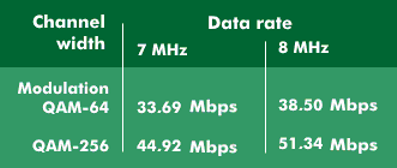DVB cable (CATV) (DVB-C)
DVB Cable (DVB-C) is the variant of DigitalVideoBroadcasting (DVB) for the transmission of digital TV via broadband cable networks(BK). The specifications of DVB-C are based on those of DVB-S. For video compression, DVB-C uses MPEG-2 or MPEG-4.
As a modulation technique, DVG-C uses quadrature amplitude modulation (64QAM); although higher modulation schemes are also supported. The frame length in the transport stream is 204 bytes, of which 16 bytes are used for error correction, which follows the Reed-Solomon code of 204/188 bytes.
The hyperband between 300 MHz and 450 MHz with channels S21 to S41 is available for DVB-C transmission. The bandwidths are 7 MHz and 8 MHz, the data rate is 38.5 Mbit/s with a bandwidth of 8 MHz and 64QAM, and increases to 51.3 Mbit/s with 256QAM. The DVB-C specifications provide for a return channel that must be implemented in the cable distribution networks. As with the other DVB processes, there is an improved cable variant with DVB-C2.

